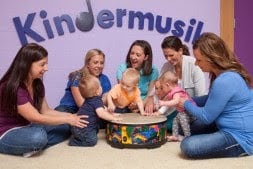Parenting Tip: Move & tap to rhythms with baby. Why? Rhythmic awareness is simply being aware of steady beat and meter in music and in our surroundings. The most fundamental property of music is beat, the underlying, unchanging, repeating pulse that occurs in song, chant, and rhyme. Your child was first exposed to be in the womb. She heard her mother's heartbeat and then, after birth, her own. Exposure to steady beat – hearing it, feeling it, being moved to it – is important for your child's developing sense of steady beat. How? Share the rhythm patterns of the Two Little Eyes fingerplay with your child Play with tempo (the speed of the music)! Bounce fast and slow to Pop! Goes the Weasel (from Kindermusik’s ‘Playtime’ CD) Tap or shake an instrument to the steady beat of the German Band Song and play the Stop & Go game when you hear the silence. Bounce to the rhythm of ‘Peekaboo, This-a-way:'( iq q iq q ) also from ‘Playtime’. Sway side to side to the Beat! Clap to the Beat! March to the Beat! Wave your arms to Beat! — All while listening and moving to the Ten Penny Bit track on the Playtime album. Play with rhythm and a home-made drum while chanting to "Monkey in a Tree" (iq iq q z ) Or drum gently right on your baby's feet, back, or legs. The more they feel the beat, the more they will begin to internalize it. Want to Learn More? On our blog: Did you know that rhythmic awareness may help predict learning disabilities in children? Kindermusik 7-Year Continuum: Now, your baby relies on you to help him notice rhythmic patterns in music. We move, tap, play instruments, and sing rhythmic patterns for baby to see, feel, and hear. As toddlers, Kindermusik kids try out ways to move their own bodies to rhythms they hear, as they see and hear the adults in the class modeling those rhythms. Kindermusik preschool classes see children begin to associate visual representations with rhythm (ie: 3 dots might mean the ‘rap, rap, rap’ of a hammer in a song about building a house). Big kids in Young Child classes take their familiarity with rhythmic sounds & movements, and go a step further – learning to read traditional rhythmic notation, and connecting pitches on the staff to those rhythms to read sheet music!



Leave a Reply